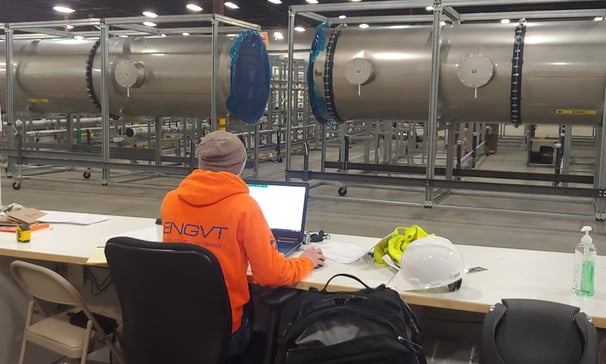Bringing Value Back to Consulting Engineering
In a previous blog, I discussed the lack of perceived value in the architectural and engineering (AE) consulting business. The problem statement was: Why are fees and services declining relative to other players in the construction space?
Many in the consulting biz lament the downward pressure on fees, conversations with clients about the minimum services and level of design they really need, and the decreasing scope of involvement of the consultant. I argued that the root cause of this was the declining relevance of the services and skills that we offer to the client embarking on a significant construction project.

ENGVT is perceived as a value added consultant and our project list reflects that – a majority of our business is post design or pre-construction (“Precon” being the current buzzword). We do our share of “engineer of record” projects but often receive requests to fill what is perceived as a valuable precon role in bringing the design to an efficiently constructed level of detail on projects that are larger than we would be able to manage as the EOR.
This normally involves some programming consultations, looking for potential construction productivity improvement opportunities, followed by active involvement in the BIM coordination process and taking the lead role in the creation of “4D” content to address the often ignored “I” in BIM – Information. We are also often contracted to generate fabrication documents (which are different than construction documents) from the model we have created.
These are all value added services that we offer on both small to medium sized projects where we are EOR, as well as larger construction projects where we are a second or even third tier sub. A good example of this is our work in the semiconductor market. We perform quite a few tool installation projects where we are the end-to-end provider. We design, stamp, bid, coordinate, modularize and create fabrication drawings, and manage field construction on these smaller scale projects.
On the other side of the coin, we also do large scale modularization (LSM) of service-intensive areas of semiconductor fabs that are typically multi-billion dollar programs, well beyond our capacity to execute as the EOR. These LSM projects can range from $15M to $100M or more in construction value and we are contracted either to the General Contractor or a subcontractor, not to the owner directly.
The moral of the story here is that while consultants will always prefer to work for the owner directly, and prefer to have full authority and contractual superiority, that sort of rigidity will narrow your firm’s funnel to projects of a size and scope that fit your capacity and expertise. Similarly, most engineering firms would never consider working for a contractor - and this friction prevents true collaboration from happening.
Too often, the AE wants to arm-wave detail and accept no final responsibility for constructability since the business model has become deflecting liability by having good “CYA” notes absolving us from having to get things right the first time. We have taken to spending too much energy on good lawyering and not enough energy on good engineering.
Instead, we need to actively promote accountability within our businesses, and that starts with our design deliverables. In my experience as an engineering manager, a CYA note is a big obvious rock to turn over. Underneath you will find a pile of questions your engineer could not technically, or did not have the time to answer.
BE ACCOUNTABLE
If you as senior partner priced the job and you underestimated the complexity, own it. Once you agree on a fee, you own getting the job done for that fee, not trimming the deliverables back to hit your number. Give your engineers the time and cover they need to firm up those details and finish their job and be accountable to your management for the shortfall. Without a feedback loop from top to bottom, we will never get our fees on point.
During design reviews, ferret out all those CYA notes, highlight them, circle them in red, find all those areas where if you were an estimator you could not price the work. Send your team back to plug those holes or structure the scope of work such that the contractors have a firm basis for pricing with minimal grey areas.
BE OPEN
During the bidding phase, be open to the value that the contractors bring to the table. It's possible that,as an engineer and not a builder, some of the details that you developed were not practical and there is a better way to execute them that still maintains design intent. Be open and flexible to that feedback.
I like to insist that the bidders price the plans as issued (with supporting RFIs as needed) to establish a crisp baseline during bid, but I also ask that they provide an alternate price with an add/deduct for a better solution that they may have to a thorny issue. This allows the contractor to show their value and helps you and the owner identify the strongest partner, not just the lowest price.
Similarly, during construction don’t deflect or rubber stamp submittals. If you see something you don’t like or understand, open a dialog before you reject anything. That one hour meeting can save two weeks or more of the endless review-reject-return-resubmit-review paper shuffle that will hold up the whole project. Be a resource not a hindrance.
COLLABORATE
If an RFI comes through, 9 times out of 10 the contractor has already figured out what they need to do but need the proper engineering sign off to proceed. Reach out to them and listen to their issue and preferred solution and if it works for you, document it and approve. If they don’t have a solution ready it is because you did not tell them clearly in your construction documents what your intent was or you have really designed them into a corner. In other words, neither one of you know what to do. Have a collaborative meeting to dig into the issue, and then issue a coordinated solution. In most cases you should sketch up a detail to go along with it or a formal revision and to document the outcome so that they can easily price the change. Don’t try to avoid revisions and documentation as a backdoor way of avoiding change orders. Our job is producing clear, detailed construction documents for the trades to use, that is the most basic value we bring to a construction project. The best way to ensure that what you intended is what gets built is to draw it up in detail, and the contractor can help you get there. They also deserve to get paid for it if it is a change with cost impact.
Some issues won’t present themselves until the contractor goes to put the pieces together in the field. When you see something built that differs significantly from what you designed, don’t immediately reject it. Grab the trade superintendent and have them walk you through it and explain why that was the outcome. By now, you hopefully have established a good working relationship with the trades and they will call you first. If you haven’t, expect some surprises.
Other times there will have been a misinterpretation of design intent and rework will be inevitable. This is the case when there is an unhealthy engineer-contractor relationship that is lacking mutual respect and acknowledgment of each other’s value. In such situations, contractors may simply make a best guess and build what they want because they feel they are working from a weak package. Other times, with a little effort and flexibility, and maybe a confirming RFI, or drawing revision to capture and approve aspects of the change, a costly rework can be avoided. This will be impossible if everyone retreats to their corners and hides behind the legal jargon on the drawings. The job will halt, time will be lost, costs will escalate, and everyone will come out looking the worse for it. You may even lose a client in the process.
In all these examples, the underlying theme, stated simply, is to be accountable. Instill a culture of accountability in your organization from top to bottom. Do your job and make sure your people are enabled to do theirs. Finish those details and be accountable for them. If something turns out to be incorrect or not buildable, own it and actively engage with the trades to figure out a solution, leaving ego aside. Ensure that the solution is properly documented so that the contractor can get paid if there was a cost impact. Culturally, ensure that your direct reports embrace accountability and, as their manager, provide them with the support that they need to focus on positive outcomes rather than wasting time and energy crafting CYA notes to protect themselves from negative consequences.
Accountability is something we can implement without spending a nickel. We don’t need to invest in new software or training or hire new talent or gain new skills. Accountability is a foundational attitude shift that needs to take place in our industry if we are to be seen as a valuable resource to the construction process, and that needs to be established first before we can sustainably grow our footprint in that space.


